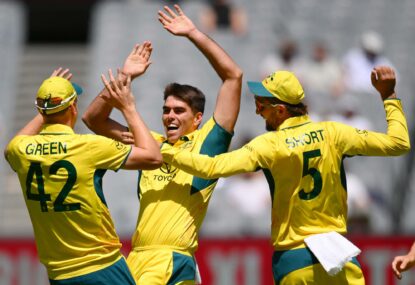 “The reports of my death have been greatly exaggerated,” Mark Twain is apocryphally credited with writing to a newspaper journalist. On the latest evidence, one-day cricket should be penning a letter along similar lines.
“The reports of my death have been greatly exaggerated,” Mark Twain is apocryphally credited with writing to a newspaper journalist. On the latest evidence, one-day cricket should be penning a letter along similar lines.
The last few years have seen the 50-over format become the dog that sportswriters and cricket pundits most love to kick. It’s stale, it’s out of date, it’s long-winded, it’s dull, and no-one cares anymore. T20 will kill it and feast on its boring, elongated corpse.
It’s just that someone has forgotten to pass all these unassailable truths on to the players. And the fans. And the game itself.
My last column looked at the brilliant contests in the World Cup’s group stages, defying a poor format. Half a dozen absolute classics, and several other fine matches to accompany them.
Nor is it just about close results – the standard of play to the end of the group stage touched great heights as well.
The era’s premier batsman, Sachin Tendulkar, scored his 98th and 99th international centuries, both against top opposition, though true to the star-crossed form of his career, neither resulted in an Indian win.
His is a combination of vintage technique and modern tactics. His first fifty against South Africa came from 33 balls, yet contained only classical cricket shots.
Ryan ten Doeschate sits next to Tendulkar alphabetically, and at the far end of the spectrum to him in cricketing prestige. Yet the South African Dutchman earned David Lloyd’s nickname of ‘ten Doesdulkar’, bestowed upon him during his hundred against England.
To the end of the group stage, he was the only batsman to match Tendulkar and AB de Villiers with two centuries, and sat seventh on the runscorers list, ahead of names like Amla, Watson, Kallis, and Gayle. He was the only Associate batsman in the top 15 on that chart, and the only one in the top 20 for averages.
And like Tendulkar, neither of his centuries was rewarded with a victory.
Also like Tendulkar, Mahela Jayawardene and Kumar Sangakkara combine classy strokeplay with dominant scoring. Sangakkara was the Cup’s leading group stage scorer, with 363, and despite only one century is averaging 121. Jayawardene scored Sri Lanka’s fastest World Cup hundred in their opening fixture.
Ross Taylor was the tournament’s hitman, dumping the ball over the ropes 13 times. Against Pakistan, he went from 69 off 108 balls, to 131 off 124, in the space of five overs. Kieron Pollard had 11 sixes from 113 balls faced, with a tournament strike rate of 158 – the highest by any batsman who has faced more than eight balls.
Sehwag’s 175 from 140 in the tournament opener had many thinking about another ODI double-hundred. Then there was Hiral Patel’s fearless assault on Australia, the Canadian teenager ambushing the Aussies’ extreme pace trio with a half-century off 37 deliveries.
With the ball, Shahid Afridi wove spells around his opposition, including Sri Lanka at home, and lead the tournament with 17 wickets. Umar Gul, the key man in Pakistan’s T20 World Cup win, is shaping to take on the same role here.
Lasith Malinga snared a hat-trick, his second in World Cups, in a six-wicket haul. Kemar Roach mimicked him, in a run of 13 wickets at 12 apiece. Ravi Rampaul took five on his World Cup debut.
Imran Tahir is the great story of the World Cup – the 31-year-old cricket journeyman finally passing the administrative obstacles to playing for his adopted South Africa. A high-arm bouncy leg-spinner, he’s grabbed 12 wickets from his four matches, at the astonishing average of 9.83 runs apiece.
Brett Lee’s is another great story – for the paceman to have made such a successful comeback at the age of 34 is an enormous credit to him and those who backed him.
Lee brings heart and a ready smile to the team. His efforts alone kept them in it against Pakistan. His first wicket in particular, summed up everything he offers – anticipation, athleticism, body language, enthusiasm, and commitment, coupled with splice-high bounce and a truly heavy ball. Surely no other paceman takes so many wickets caught and bowled.
There was Canada’s best 50 overs of the tournament, scrapping Pakistan out for 184. There was Chris Mpofu’s sublime run-out from the boundary to dismiss Ricky Ponting.
There was Musfhiqur Rahim’s two-bite dismissal of Matt Prior, pulling the stump out of the ground when the Englishman strayed from his crease after the first stumping attempt. There was Tillakaratne Dilshan’s quadrilateral effort against Zimbabwe, 144 followed by 4/4 with the ball.
Of course there have been a few less savoury moments (though quite why the headline “West Indies stoned” should have been a shock to anyone, I’m not quite sure). But the great stories have vastly outweighed them.
Nor is it the case that a tremendous World Cup has suddenly seen the ODI reborn. Back in November I wrote about some of 2010’s highlights, many of them from ODIs. In particular was Sri Lanka’s miracle in Melbourne, and the five-round South Africa-Pakistan classic in the Middle East.
Cricinfo’s Osman Samiuddin wrote a month ago in a similar vein, citing the same matches. It was, he suggested, “not a revival of the format so much as a reminder of what is good about it.”
The 50-over game allows cricket its ebb and flow. Momentum can shift, slip, swing away. Ascendancy can change with each over. It is “an examination prolonged enough of any player, to produce or confirm quality and greatness.”
T20 has its good points, but is inherently limited in its scope. It has one gear, one purpose, one technique. Finales are thrillers or a damp squibs, but even the thrillers feel manufactured. The ODI requires an investment, and it’s that build-up that makes a grandstand finish such a payoff.
“I have no reason to believe I am alone in enjoying these moments,” Samiuddin wrote. “The majority of these matches were watched in sold-out stadiums. TV ratings were healthy.”
Just as they have been for the World Cup. It’s not that one-day cricket is boring. It’s that boring one-day cricket is boring.
Which is not a unique characteristic. Watching AFL teams stodge out last-quarter foregone conclusions in a mud-bath hardly makes the pulse flutter either. Nor does watching Blackpool and Wolves play a nil-all pinball fest on an English winter evening.
Chelsea’s drought-breaking champions of 2005 were tagged as 1-0 grinders. But then there was their home Champion’s League tie against Barcelona: three stunning Chelsea goals in the first 19 minutes, two Ronaldinho specials to put Barca up on aggregate, and John Terry’s sealing header in the dying minutes.
We often hear sport used as a metaphor for life. Well, life is not always interesting. The point of the sublime is precisely that it doesn’t happen every time around. Rarity is its defining characteristic. Otherwise, it would become its own kind of mediocrity.
In my other life as a literary editor, I’ve read thousands of articles, stories, poems. Many are by young or inexperienced writers. Many are not very good. The repetitive and the unimaginative can on occasion make the job feel a cross to be borne.
Yet then there are the moments when you uncover something wonderful, bursting with wit or skill or pathos. There are moments when a new writer simply floors you, and you wonder where they could have been all this time.
Cricket is a game whose narrative matters more than its athletic feats. Its devotees are drawn to the stories, the history, the trivia: that which unfolds during the course of one match, and that which adds to the great archive already extant.
If a Test is a novel, Twenty20 is a limerick. One-dayers are somewhere in between; a hybrid creation with what poet Kevin Brophy calls the “modest proportions and outlandish ambition of the short story.”
For Samiuddin, one-day feats “are tales that cannot be told in any other format. They are unique in their contribution to the tapestry of the game. Attempts to keep alive the possibility of them recurring cannot so readily be shunted aside.”
Some administrators would love to do just that, in favour of the more convenient and lucrative form. Panic-merchants always have the loudest voices. And as climate change ‘sceptics’ have shown, endless repetition alone can be enough to lend the most insupportable statement credibility.
But even if a decline exists, it isn’t terminal. The one-dayer is again as Brophy sees the short story: “a brief work of art, too often crowded into small spaces with too many other short existences.”
This is where its appeal has suffered. So show some restraint. Cut out the dross. Make it matter. And be prepared to ride out the capriciousness of audiences and of life.
Tastes ebb and flow like cricket. For several decades we were told the short story was dead, dying, gone. Major publishing houses wouldn’t touch them. Now all of a sudden they’re back, a hot ticket item: Nam Le, Wells Tower, Haruki Murakami are new firmament stars.
For the past few weeks, the authors of the one-day game have been weaving their own short-form creations, building their narratives – all of it improvised, all with the thrill of high-wire work, all in front of a live studio audience.
Sometimes, the results are ordinary, a seeming waste of time. Sometimes they’re stunning, lifting us from mediocrity to some other, higher place. This is the risk inherent in the way these stories are written.
It would be a great shame if the book were closed on it for good.





































































































